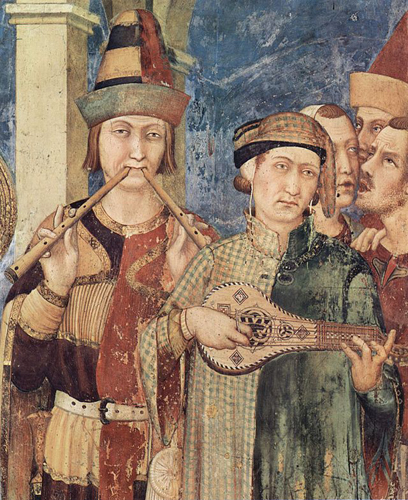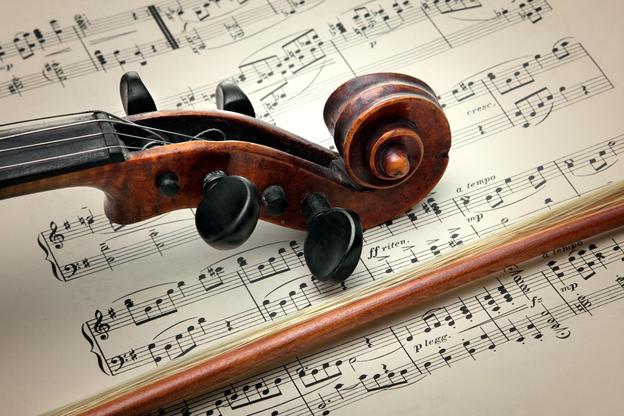Music to the ears? John Bensalhia looks at the styles, instruments and composers of the Renaissance age.
(Read Part 1 - Introduction and Overview here; Part 2 - Philosophy here; Part 3 - Literature here; Part 4 - Science here; read Part 5 - Art here.)
BACKGROUND
The music of the Renaissance is typically in keeping with the values and the ambition of the era. There is a greater depth and range to the music produced in the Renaissance, with bigger emphasis on personal expression and more sophistication in the arrangements. It's an era that champions the Humanist, so, naturally, the individual styles and quirks come through loud and clear. The trends of Humanism would also be seen in the introduction of the Madrigal (see later section for more details).
Music becomes a key part of the Renaissance in that it's wider to a greater audience, thanks to the introduction of the printing press. Music could now be distributed on a wider scale at a relatively cheap cost, and as a result, there was greater room for flexibility and different styles of music. From the madrigal to the motet and from the instrumental through to the mass, there were different methods of expressing music – not to mention music performed for sacred or secular uses.
PRINTING THE MUSIC
Originally, music had been either learned by ear or copied by hand – both were longer, time-consuming processes. So the arrival of the printing press provided an opportunity to showcase music in an easier, faster manner. One Venetian in particular provided greater accessibility when it came to music. Venetian printer Ottaviano Petrucci published a collection of polyphonic works in 1501 called Harmonice Musices Odhecaton. This and subsequent books provided aspiring musicians with notated music – a means to learn and play music with greater ease.

FROTTOLAS AND MADRIGALS
There were many types of music throughout the Renaissance. Some of these would influence future elements of Renaissance music – take the frottola, for example. The frottola was a popular type of secular song in the 15th and 16th centuries. The frottola was designed for three or four people to sing – with the uppermost voice being responsible for the main melody of the song.
The next phase of this was the madrigal, a popular type of song designed for three to six voices. Romance, emotion, thoughts... the madrigal put what were essentially poems and text to melodic, danceable rhythms and tunes. The madrigal was again in tune with Humanism, due in part to poet and theorist Pietro Bembo, who had advocated the strength of Petrarch's works – the madrigal form was regarded as being a good type of backdrop for such works. By the 1530s, the first overt mention of the madrigal had been seen in Philippe Verdelot's first book of madrigals entitled Madrigali de diversi musici: libro primo de la serena. Prior to this, composer Bernardo Pisano had produced a collection of secular music, 1520's Musica di messer Bernardo Pisano sopra le canzone del Petrarcha.
By the 1550s, the madrigal had grown in popularity, having graduated from Florence and Rome to areas such as Venice. Countless madrigals were now being produced by the likes of Giovanni Pierluigi da Palestrina (see composers).
POLYPHONIC SPREE
 Another notable style of Renaissance music was that of polyphony, a more sacred type of music sung by larger groups of people. Polyphonic music involved different vocal harmonies and melodies which would be sung at the same time. Polyphonic potential was seen to develop over time. Places such as the Basilica San Marco di Venezia would play host to polychoral music, which would present listeners with a full-on, imposing amalgamation of singers, as well as strings and brass.
Another notable style of Renaissance music was that of polyphony, a more sacred type of music sung by larger groups of people. Polyphonic music involved different vocal harmonies and melodies which would be sung at the same time. Polyphonic potential was seen to develop over time. Places such as the Basilica San Marco di Venezia would play host to polychoral music, which would present listeners with a full-on, imposing amalgamation of singers, as well as strings and brass.
Polyphonic music reached an apotheosis with the introduction of what was known as Roman School, seen in the later part of the Renaissance era. The Roman School was a gathering of composers of church music in the area. This included composers such as Giovanni Pierluigi da Palestrina, Giovanni Animuccia and Annibale Zolio.
Music from the Roman School was affected by a number of outside influences. One of these was the growing number of composers from France and the Netherlands. The likes of Obrecht and Arcadelt had come to Italy, and their style of composition became an influence on musicians of the Roman School. In addition, the Council of Trent had influence over the sort of music being produced. The Council of Trent made a number of recommendations, including a leaning towards sombre but dignified sacred music and clearly understood and heard words. The culmination of these influences helped a pinnacle to be reached in the standards of polyphonic music in the era of the Renaissance.
INSTRUMENTAL VARIABLES
A number of musical instruments were played in the Italian Renaissance era. The musical instrument was a key tool in accompanying singers express their music or for performances such as dancing. Think of the Renaissance documentaries or dramas, and the familiar instruments on the soundtrack practically leap out of the speakers at you – the harpsichord, for example. In particular, in the early part of the Renaissance, the ottavino was especially popular – a harpsichord that played at octave pitch. The recorder was another key musical staple of the period, whether played for the clergy or for the nobles or for the everyday folk.
Then there were variations on the violin – the violin itself progressed considerably during the Renaissance in terms of the sound, the tone and the volume. The Renaissance fiddle was one such example used in the era.
Italian musicians would also use the lira da braccio, an instrument along the lines of a medieval fiddle to bring poems and Humanist verse to life.
The lute was also a common instrument used in the Renaissance. The lute allowed for musicians to improvise when accompanying poems and verses. The common method for playing the lute would be to pluck the instrument with the fingertips by the late 15th century. The Chitarra Italiana was also shaped like a lute and could be plucked by the player – although it's possible to see similarities to the guitar in that there were less strings (four or five, as compared to the average of 15 strings for the lute). Tuning techniques are also similar to the guitar. The viola da mano, a guitar-shaped string instrument, was also a common presence in Italy during the Renaissance.

NOTABLE COMPOSERS AND MUSICIANS
Giovanni Pierluigi da Palestrina
A prolific and influential composer, Giovanni Pierluigi Da Palestrina produced many musical pieces in his time. He ran the whole gamut from madrigals through to hymns through to motets and to masses. His works include Missa Papae Marcelli, Missa sine Nomine, A solis ortu caroline, Rex gloriose martyrum and O sacrum convivium. One of the main icons of Renaissance sacred music, Palestrina was maestro di cappella at Cappella Giulia, St Peter's in Rome. Revered for his smoother, clearer compositions, his music was highly expressive, distinctive and in perfect sympathy with the written texts.
Luca Marenzio
One of the foremost composers of madrigals in the era, Luca Marenzio saw his popularity soar in the Renaissance. He published more than 20 books of madrigals in his life, which were not only welcomed in his home country, but across Europe.
Marenzio's madrigals were eclectic in tone and style, ranging from the more serious to the light-hearted type, using distinctive 'text painting' to bring texts to life (using sources such as Dante and Petrarch). The lighter style of madrigal was especially welcomed in the 1560s, with an emphasis on dance, rhythm and light-hearted, looser subject matter.
Bartolomeo Tromboncino
Bartolomeo Tromboncino was a regarded composer of the frottola, composing 176 in total. He selected texts from the likes of Petrarch and Sannazaro for his music, opting for a varied and diverse frottola style – albeit with a greater emphasis than usual on polyphony. His compositions included Come haro dunque ardire.
Marchetto Cara
This multi-talented musician not only composed a string of frottolas, he was also a singer and lutenist. Although Cara also produced some sacred compositions (such as Salve Regina for three voices), his main forte was producing spirited, catchy frottolas, including Io non compro più speranza.
Luzzasco Luzzaschi
Luzzasco Luzzaschi's madrigals were composed to the highest standard, offering a level of sophistication and opportunity for densely layered vocals. In addition to composing madrigals, Luzzaschi was a teacher and also an organist (he played the organ for the d'Este court). His works include Il primo libro de madrigali a cinque voci.
Lodovico Agostini
Lodovico Agostini's madrigals were not your average tunes. Agostini favoured a more experimental approach, with unusual, avant-garde-style arrangements. His madrigals were designed to be thought about, with conundrums, puzzles and riddles being the order of the day. Agostini's Enigmi musicali was one such quirky offering, with riddles and unusual arrangements challenging the listener.
Claudio Monteverdi
One of the composers who bridged the Renaissance and Baroque eras, Claudio Monteverdi came to the music scene with madrigal compositions such as Madrigali dei guerrieri ed amorosi. He moved to a monodic style of composition from earlier polyphonic methods. Monteverdi's many accomplishments include what is said to be the first dramatic opera, Orfeo.
Giovanni Gabrieli
Also bridging the Renaissance and Baroque eras of music was Giovanni Gabrieli. Composer of sacred music, Gabrieli would look to the San Marco Church for inspiration, using its unusual design to produce equally unique musical pieces. Gabrieli would also create the technique of antiphone – in which a group of instrumentalists or singers, first heard on the left, would then be heard by another group on the right.













